The Influence of Environmental Conditions on Intake Behavior and Activity by Feedlot Steers Fed Corn or Barley-Based Diets
Abstract
Simple Summary
Abstract
1. Introduction
2. Materials and Methods
3. Results
4. Discussion
5. Conclusions
Supplementary Materials
Author Contributions
Funding
Institutional Review Board Statement
Data Availability Statement
Conflicts of Interest
References
- Birkelo, C.P.; Johnson, D.E.; Phetteplace, H.P. Maintenance requirements of beef cattle as affected by season on different planes of nutrition. J. Anim. Sci. 1991, 69, 1214–1222. [Google Scholar] [CrossRef]
- Delfino, J.G.; Mathison, G.W. Effects of cold environment and intake level on the energetic efficiency of feedlot steers. J. Anim. Sci. 1991, 69, 4577–4587. [Google Scholar] [CrossRef]
- Mader, T.L. Environmental stress in confined beef cattle. J. Anim. Sci. 2003, 81, E110–E119. [Google Scholar] [CrossRef]
- Elam, C.J. Problems Related to Intensive Indoor and Outdoor Beef Production Systems. J. Anim. Sci. 1971, 32, 554–559. [Google Scholar] [CrossRef]
- Milligan, J.D.; Christison, G.I. Effects of severe winter conditions on performance of feedlot steers. Can. J. Anim. Sci. 1974, 54, 605–610. [Google Scholar] [CrossRef]
- Webster, A.J.F. Direct effects of cold weather on the energetic efficiency of beef production in different regions of Canada. Can. J. Anim. Sci. 1970, 50, 563–573. [Google Scholar] [CrossRef]
- Webster, A.J. Prediction of heat losses from cattle exposed to cold outdoor environments. J. Appl. Physiol. 1971, 30, 684–690. [Google Scholar] [CrossRef]
- Gonyou, H.; Christopherson, R.; Young, B. Effects of cold temperature and winter conditions on some aspects of behaviour of feedlot cattle. Appl. Anim. Ethol. 1979, 5, 113–124. [Google Scholar] [CrossRef]
- Young, B.A. Cold Stress as it Affects Animal Production. J. Anim. Sci. 1981, 52, 154–163. [Google Scholar] [CrossRef]
- Samuelson, K.L.; Hubbert, M.E.; Galyean, M.L.; Löest, C.A. Nutritional recommendations of feedlot consulting nutritionists: The 2015 New Mexico State and Texas Tech University survey1. J. Anim. Sci. 2016, 94, 2648–2663. [Google Scholar] [CrossRef]
- Bowman, J.G.P. Barley for Beef Cattle. In Cow-Calf Management Guide. Nutrition Section, 2nd ed.; Western Beef Resource Committee; JRAdams Publishing: Moscow, ID, USA, 2001; Volume 332, pp. 1–5. [Google Scholar]
- NRC. Nutrient Requirements of Beef Cattle, 8th ed.; Natl. Acad. Press: Washington, DC, USA, 2016. [Google Scholar]
- Bowman, J.G.P.; Boss, D.L.; Surber, L.M.M.; Blake, T.K. Estimation of the net energy value of barley for finishing beef steers1. Transl. Anim. Sci. 2019, 3, 1550–1560. [Google Scholar] [CrossRef]
- Nichols, W.T. Wheat Versus Corn and Barley in Beef Finishing Rations. Master’s Thesis, Oregon State University, Corvallis, OR, USA, 1988. [Google Scholar]
- Dion, S.; Seoane, J.R. Nutritive value of corn, barley, wheat and oats fed with medium quality hay to fattening steers. Can. J. Anim. Sci. 1992, 72, 367–373. [Google Scholar] [CrossRef]
- DelCurto-Wyffels, H.; Dafoe, J.; Parsons, C.; Boss, D.; DelCurto, T.; Wyffels, S.; Van Emon, M.; Bowman, J. Corn versus Barley in Finishing Diets: Effect on Steer Performance and Feeding Behavior. Animals 2021, 11, 935. [Google Scholar] [CrossRef]
- Ørskov, E.R. Starch Digestion and Utilization in Ruminants. J. Anim. Sci. 1986, 63, 1624–1633. [Google Scholar] [CrossRef] [PubMed]
- Surber, L.; Bowman, J.; Daniels, T.; Milner, T.; Lewis, A.; Coulson, D.; Blake, T. Feeding value of barley varieties for finishing cattle. In Proceedings-American Society of Animal Science Western Section; New Mexico State University: Las Cruces, NM, USA, 1998; Volume 49, pp. 268–271. [Google Scholar]
- Weary, D.M.; Huzzey, J.M.; Von Keyserlingk, M.A.G. Board-invited review: Using behavior to predict and identify ill health in animals1. J. Anim. Sci. 2009, 87, 770–777. [Google Scholar] [CrossRef]
- Wolfger, B.; Mang, A.; Cook, N.; Orsel, K.; Timsit, E. Technical note: Evaluation of a system for monitoring individual feeding behavior and activity in beef cattle. J. Anim. Sci. 2015, 93, 4110–4114. [Google Scholar] [CrossRef]
- Arthur, P.F.; Archer, J.A.; Herd, R.M. Feed intake and efficiency in beef cattle: Overview of recent Australian research and challenges for the future. Aust. J. Exp. Agric. 2004, 44, 361–369. [Google Scholar] [CrossRef]
- Barley Breeding Program, Montana. State University Malt Variety Dictionary—Hockett. 2008. Available online: https://www.montana.edu/barleybreeding/learning-center/malt-variety-dictionary/two-row/hockett.html (accessed on 10 December 2020).
- Wang, Z.; Nkrumah, J.D.; Li, C.; Basarab, J.A.; Goonewardene, L.A.; Okine, E.K.; Crews, D.H.; Moore, S.S. Test duration for growth, feed intake, and feed efficiency in beef cattle using the GrowSafe System1. J. Anim. Sci. 2006, 84, 2289–2298. [Google Scholar] [CrossRef]
- Ito, K.; Weary, D.; Von Keyserlingk, M. Lying behavior: Assessing within- and between-herd variation in free-stall-housed dairy cows. J. Dairy Sci. 2009, 92, 4412–4420. [Google Scholar] [CrossRef]
- Osczevski, R.; Bluestein, M. The new wind chill equivalent temperature chart. Bull. Am. Meteorol. Soc. 2005, 86, 1453–1458. [Google Scholar] [CrossRef]
- Tucker, C.B.; Rogers, A.R.; Verkerk, G.A.; Kendall, P.E.; Webster, J.R.; Matthews, L.R. Effects of shelter and body condition on the behaviour and physiology of dairy cattle in winter. Appl. Anim. Behav. Sci. 2007, 105, 1–13. [Google Scholar] [CrossRef]
- Graunke, K.L.; Schuster, T.; Lidfors, L.M. Influence of weather on the behaviour of outdoor-wintered beef cattle in Scandinavia. Livest. Sci. 2011, 136, 247–255. [Google Scholar] [CrossRef]
- Senft, R.L.; Rittenhouse, L.R. A Model of Thermal Acclimation in Cattle. J. Anim. Sci. 1985, 61, 297–306. [Google Scholar] [CrossRef] [PubMed]
- Fox, J.; Weisberg, S. An R Companion to Applied Regression, 2nd ed.; Sage: Thousand Oaks, CA, USA, 2011; Available online: http://socserv.socsci.mcmaster.ca/jfox/Books/Companion (accessed on 1 December 2020).
- Bates, D.; Mächler, M.; Bolker, B.; Walker, S. Fitting Linear Mixed-Effects Models Usinglme4. J. Stat. Softw. 2015, 67, 1–48. [Google Scholar] [CrossRef]
- Lenth, R. Emmeans: Estimated Marginal Means, Aka Least-Squares Means. R Package. Version 1.3.3. 2019. Available online: https://CRAN.R-project.org/package=emmeans (accessed on 1 December 2020).
- R Core Team. R: A Language and Environment for Statistical Computing; R Foundation for Statistical Computing: Vienna, Austria, 2018; Available online: https://www.R-project.org (accessed on 15 November 2018).
- Golden, J.W.; Kerley, M.S.; Kolath, W.H. The relationship of feeding behavior to residual feed intake in crossbred Angus steers fed traditional and no-roughage diets1. J. Anim. Sci. 2008, 86, 180–186. [Google Scholar] [CrossRef] [PubMed]
- Schwartzkopf-Genswein, K.S.; Hickman, D.D.; Shah, M.A.; Krehbiel, C.R.; Genswein, B.M.A.; Silasi, R.; Gibb, D.G.; Crews, D.H.; McAllister, T.A. Relationship between feeding behavior and performance of feedlot steers fed barley-based diets12. J. Anim. Sci. 2011, 89, 1180–1192. [Google Scholar] [CrossRef]
- Richeson, J.T.; Lawrence, T.E.; White, B.J. Using advanced technologies to quantify beef cattle behavior. Transl. Anim. Sci. 2018, 2, 223–229. [Google Scholar] [CrossRef]
- Streeter, M.; Branine, M.; Whitley, E.; McCollum, F. Feeding behaviour of feedlot cattle: Does behaviour change with health status, environmental conditions and performance level. In Proceedings of the Plains Nutrition Council Spring Conference, San Antonio, TX, USA, 8–9 April 1999; pp. 36–47. [Google Scholar]
- Milner, T.; Bowman, J.; Sowell, B. 1995. Effects of barley variety or corn on feedlot performance and feeding behavior. In Proceedings-American Society of Animal Science Western Section; New Mexico State University: Las Cruces, NM, USA, 1995; Volume 46, pp. 539–542. [Google Scholar]
- Beverlin, S.; Havstad, K.; Ayers, E.; Petersen, M. Forage intake responses to winter cold exposure of free-ranging beef cows. Appl. Anim. Behav. Sci. 1989, 23, 75–85. [Google Scholar] [CrossRef]
- NRC. Effect of Environment on Nutrient Requirements of Domestic Animals; Natl. Acad. Press: Washington, DC, USA, 1981. [Google Scholar]
- Malechek, J.C.; Smith, B.M. Behavior of Range Cows in Response to Winter Weather. J. Range Manag. 1976, 29, 9–12. [Google Scholar] [CrossRef]
- Adams, D.C.; Nelsen, T.C.; Reynolds, W.L.; Knapp, B.W. Winter Grazing Activity and Forage Intake of Range Cows in the Northern Great Plains. J. Anim. Sci. 1986, 62, 1240–1246. [Google Scholar] [CrossRef]
- Hepola, H.; Hänninen, L.; Pursiainen, P.; Tuure, V.-M.; Syrjälä-Qvist, L.; Pyykkönen, M.; Saloniemi, H. Feed intake and oral behaviour of dairy calves housed individually or in groups in warm or cold buildings. Livest. Sci. 2006, 105, 94–104. [Google Scholar] [CrossRef]
- Frisch, J.; Vercoe, J. Liveweight gain, food intake, and eating rate in Brahman, Africander, and Shorthorn X Hereford cattle. Aust. J. Agric. Res. 1969, 20, 1189–1195. [Google Scholar] [CrossRef]
- Prawl, Z.; Hill, W.; Owens, F.; Gill, D.; Ball, R.; Porter, R. Effects of limited access time to feed on feedlot performance and carcass characteristics. J. Anim. Sci. 1997, 75, 239. [Google Scholar]
- Robert, B.; White, B.J.; Renter, D.G.; Larson, R.L. Evaluation of three-dimensional accelerometers to monitor and classify behavior patterns in cattle. Comput. Electron. Agric. 2009, 67, 80–84. [Google Scholar] [CrossRef]
- Rutten, C.; Velthuis, A.; Steeneveld, W.; Hogeveen, H. Invited review: Sensors to support health management on dairy farms. J. Dairy Sci. 2013, 96, 1928–1952. [Google Scholar] [CrossRef] [PubMed]
- Chapa, J.M.; Maschat, K.; Iwersen, M.; Baumgartner, J.; Drillich, M. Accelerometer systems as tools for health and welfare assessment in cattle and pigs—A review. Behav. Process. 2020, 181, 104262. [Google Scholar] [CrossRef] [PubMed]
- Tullo, E.; Mattachini, G.; Riva, E.; Finzi, A.; Provolo, G.; Guarino, M. Effects of Climatic Conditions on the Lying Behavior of a Group of Primiparous Dairy Cows. Animals 2019, 9, 869. [Google Scholar] [CrossRef] [PubMed]
- Schirmann, K.; Chapinal, N.; Weary, D.; Heuwieser, W.; Von Keyserlingk, M. Rumination and its relationship to feeding and lying behavior in Holstein dairy cows. J. Dairy Sci. 2012, 95, 3212–3217. [Google Scholar] [CrossRef]
- Solano, L.; Barkema, H.; Pajor, E.; Mason, S.; Leblanc, S.; Nash, C.; Haley, D.; Pellerin, D.; Rushen, J.; De Passillé, A.; et al. Associations between lying behavior and lameness in Canadian Holstein-Friesian cows housed in freestall barns. J. Dairy Sci. 2016, 99, 2086–2101. [Google Scholar] [CrossRef]
- Hendriks, S.J.; Phyn, C.V.C.; Turner, S.-A.; Mueller, K.R.; Kuhn-Sherlock, B.; Donaghy, D.J.; Huzzey, J.M.; Roche, J.R. Effect of weather on activity and lying behaviour in clinically healthy grazing dairy cows during the transition period. Anim. Prod. Sci. 2020, 60, 148. [Google Scholar] [CrossRef]
- Redbo, I.; Ehrlemark, A.; Redbo-Torstensson, P. Behavioural responses to climatic demands of dairy heifers housed outdoors. Can. J. Anim. Sci. 2001, 81, 9–15. [Google Scholar] [CrossRef]
- Schütz, K.; Clark, K.; Cox, N.; Matthews, L.; Tucker, C. 2010. Responses to short-term exposure to simulated rain and wind by dairy cattle: Time budgets, shelter use, body temperature and feed intake. Anim. Welf. 2010, 19, 375. [Google Scholar]
- Wyffels, S.A.; Dafoe, J.M.; Parsons, C.T.; Boss, D.L.; DelCurto, T.; Bowman, J.G.P. The influence of age and environmental conditions on supplement intake by beef cattle winter grazing northern mixed-grass rangelands. J. Anim. Sci. 2020, 98, 217. [Google Scholar] [CrossRef] [PubMed]
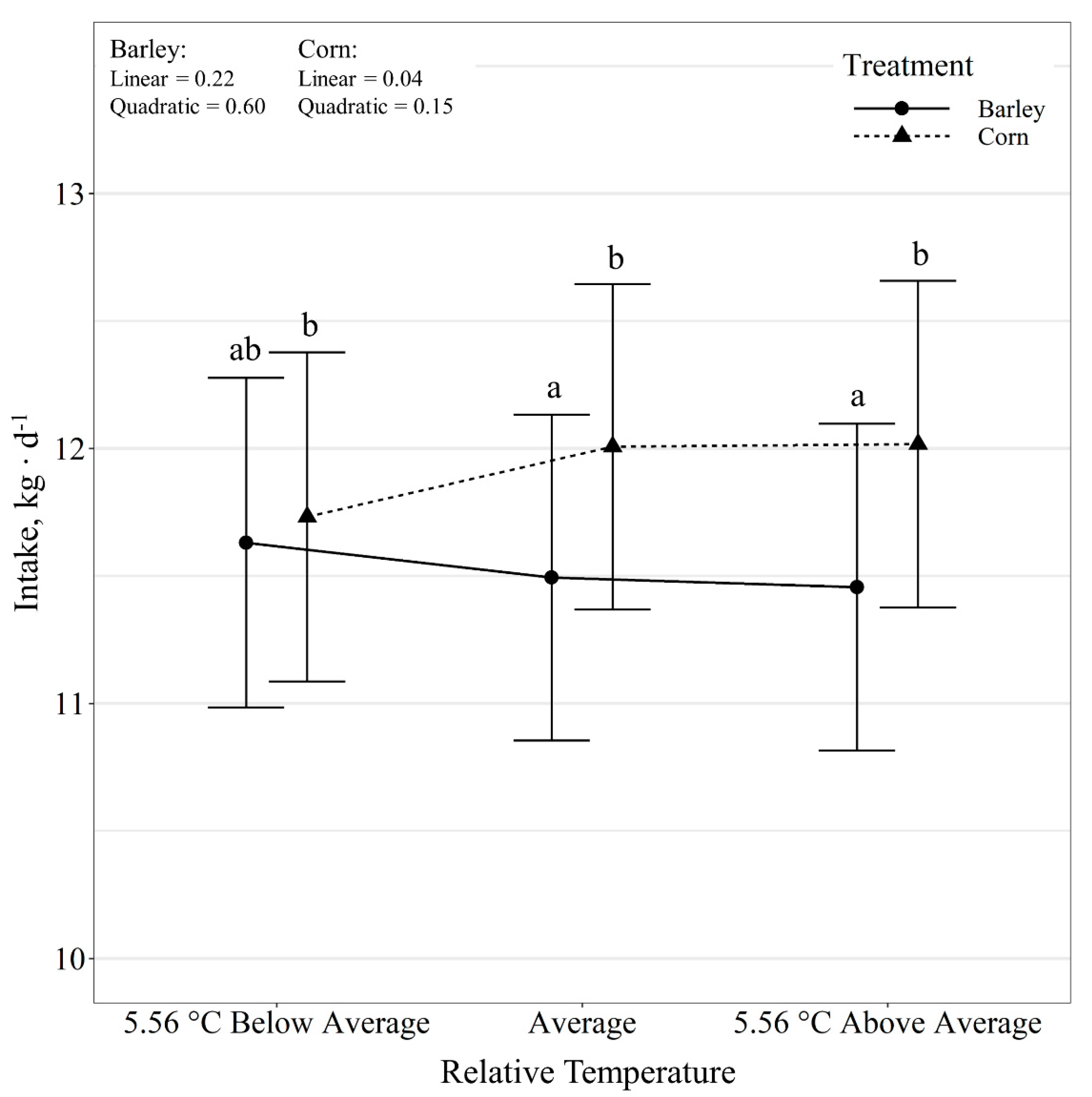
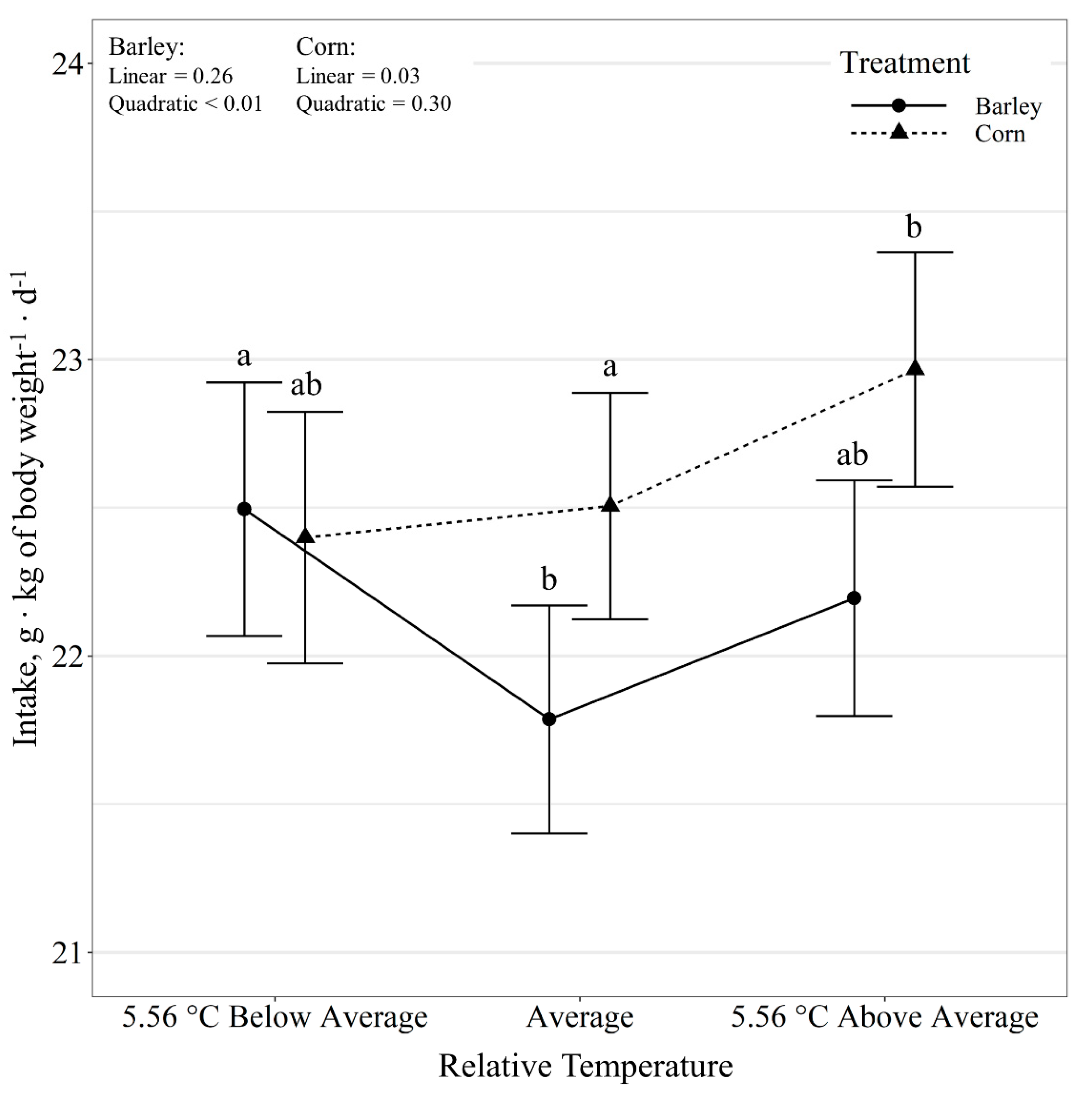
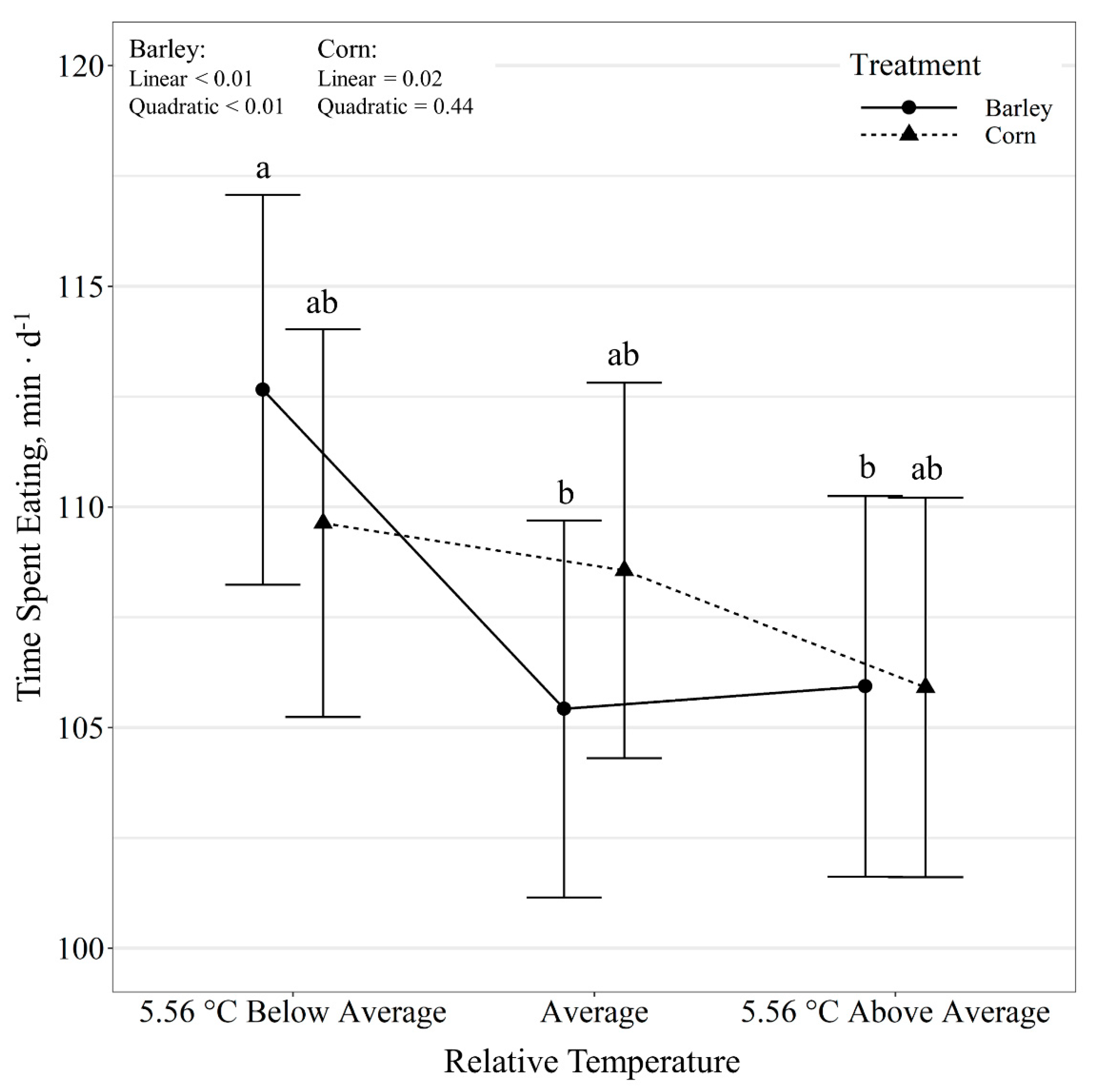
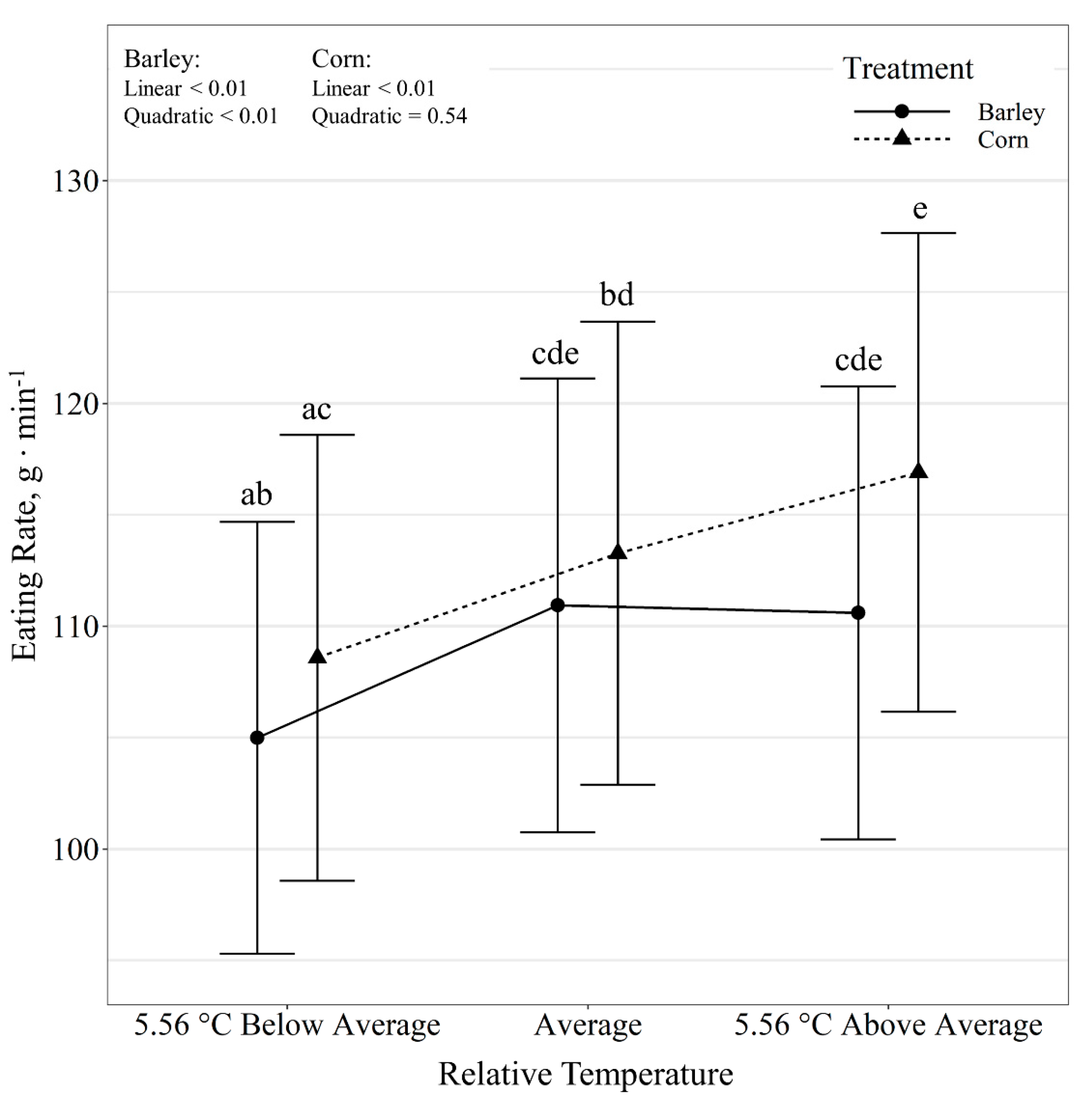
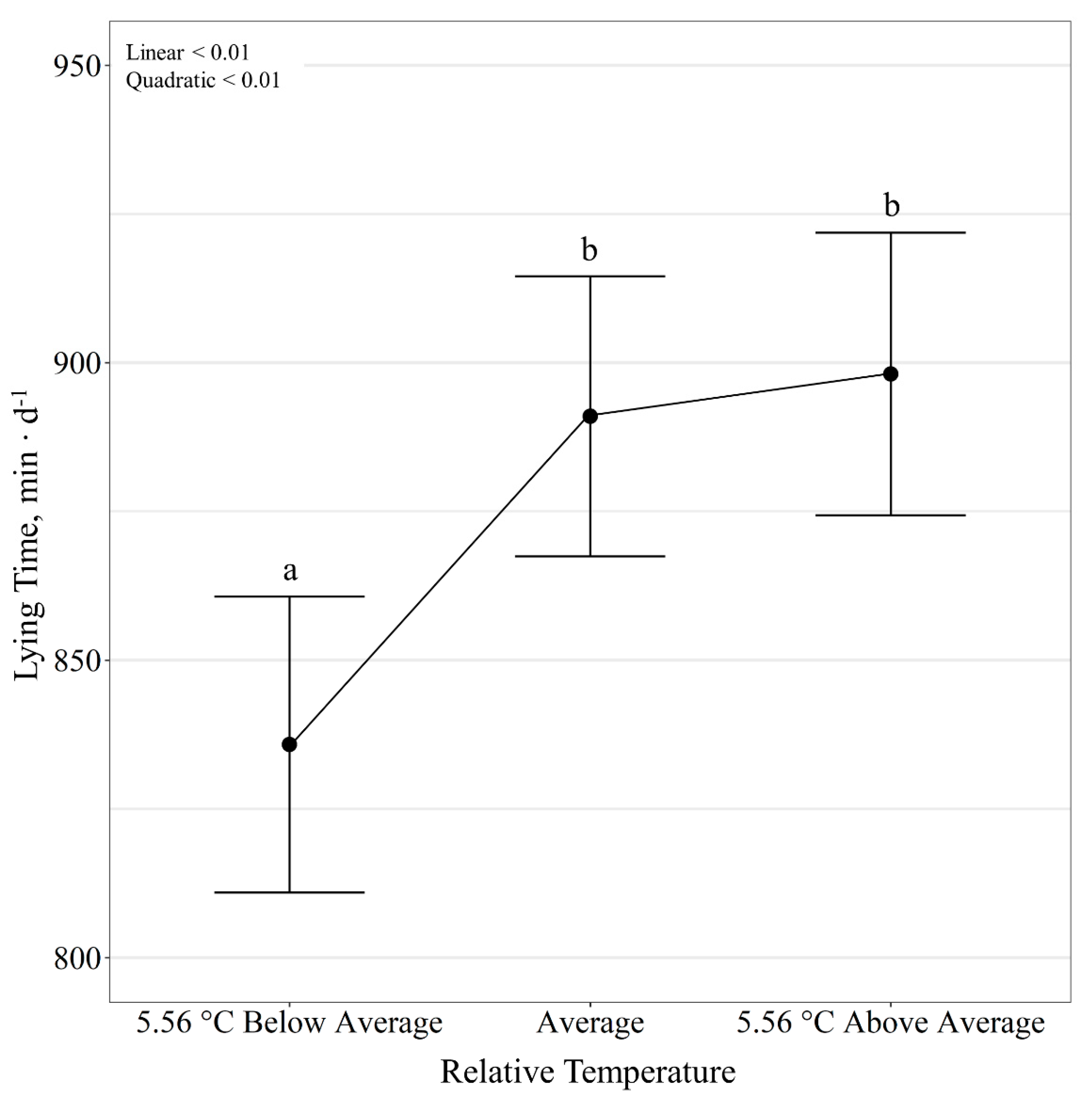
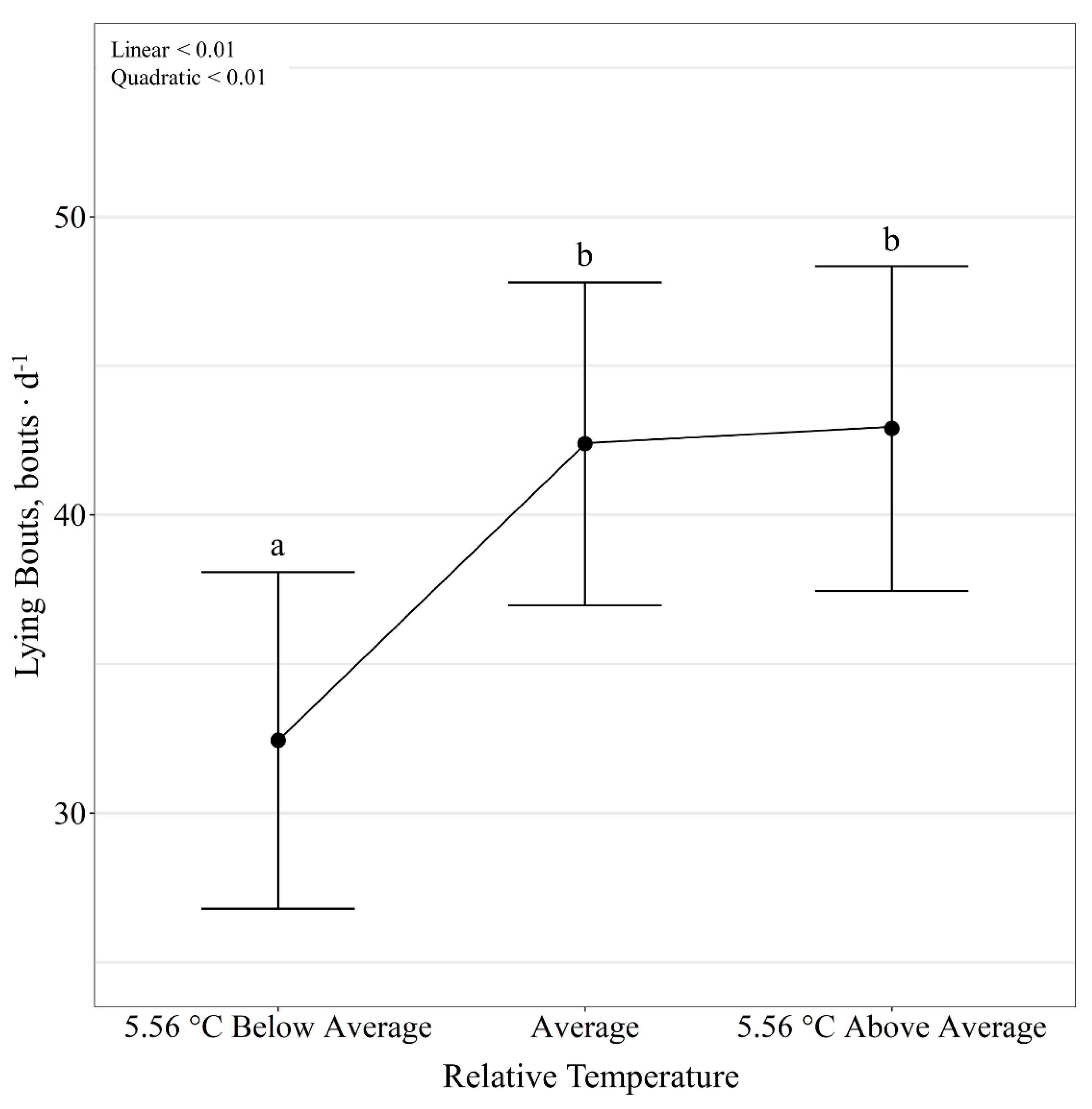

Publisher’s Note: MDPI stays neutral with regard to jurisdictional claims in published maps and institutional affiliations. |
© 2021 by the authors. Licensee MDPI, Basel, Switzerland. This article is an open access article distributed under the terms and conditions of the Creative Commons Attribution (CC BY) license (https://creativecommons.org/licenses/by/4.0/).
Share and Cite
DelCurto-Wyffels, H.M.; Dafoe, J.M.; Parsons, C.T.; Boss, D.L.; DelCurto, T.; Wyffels, S.A.; Van Emon, M.L.; Bowman, J.G.P. The Influence of Environmental Conditions on Intake Behavior and Activity by Feedlot Steers Fed Corn or Barley-Based Diets. Animals 2021, 11, 1261. https://doi.org/10.3390/ani11051261
DelCurto-Wyffels HM, Dafoe JM, Parsons CT, Boss DL, DelCurto T, Wyffels SA, Van Emon ML, Bowman JGP. The Influence of Environmental Conditions on Intake Behavior and Activity by Feedlot Steers Fed Corn or Barley-Based Diets. Animals. 2021; 11(5):1261. https://doi.org/10.3390/ani11051261
Chicago/Turabian StyleDelCurto-Wyffels, Hannah M., Julia M. Dafoe, Cory T. Parsons, Darrin L. Boss, Timothy DelCurto, Samuel A. Wyffels, Megan L. Van Emon, and Janice G. P. Bowman. 2021. "The Influence of Environmental Conditions on Intake Behavior and Activity by Feedlot Steers Fed Corn or Barley-Based Diets" Animals 11, no. 5: 1261. https://doi.org/10.3390/ani11051261
APA StyleDelCurto-Wyffels, H. M., Dafoe, J. M., Parsons, C. T., Boss, D. L., DelCurto, T., Wyffels, S. A., Van Emon, M. L., & Bowman, J. G. P. (2021). The Influence of Environmental Conditions on Intake Behavior and Activity by Feedlot Steers Fed Corn or Barley-Based Diets. Animals, 11(5), 1261. https://doi.org/10.3390/ani11051261





